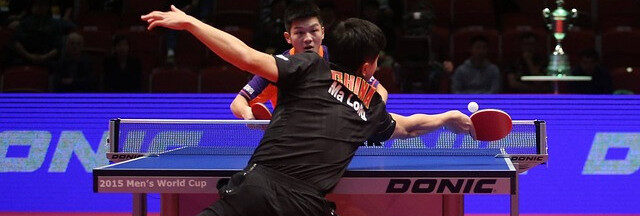
The forehand push in table tennis is one of the four fundamental shots. Therefore, it is critical to master this shot early on and to iron out any incorrect techniques. The push, along with the drive, is always one of the first shots I teach to beginners as it is important to start off with a solid basis to progress from. In this article we will delve into what the push is, its coaching points along with common errors, as well as when to use the forehand push.
What is the Forehand Push
The forehand push is primarily a defensive shot. A lot of players seem to view it as a negative shot. I disagree, as long as you perform the technique correctly and don’t ‘plonk’ it back for your opponent. You should use it as an aggressive shot rather than a shot to get the ball back. The idea of the push is to stop your opponent from playing an attacking shot, or to draw out an error.
Key Coaching Points
Just like any other shots, the forehand push can be broken down into 4 key stages. When using examples and positions of the body, it is for a right-handed player. If you are left-handed these will be the opposite for you.

The above photo is from racketinsight.com who own the rights over this.
Ready Position:
This is the position you should be in whenever in between shots. It gives you the best opportunity to get ready for whatever shot you are going to be playing next. It is important after completing a shot you should always return to this position.
- Feet slightly wider than shoulder width apart, with your right foot slightly further back than the left.
- Have a bend in the knees and body weight forwards. Should be on the balls of your feet.
- Both arms out in front of you. Playing arm should be at about a 90 degree angle and a fist length away from your body. You non-playing hand is there to help you keep balance.
- Staying fairly close to the table, do not drop too far back.
Back Swing:
Once you know what shot you are playing, you should start the back swing in preparation for this.
- Angle your bat so it is facing upwards. The forehand push is played against backspin balls, therefore it would be impossible to return the shot if you had your bat angle closed. Depending on the amount of spin that is on the ball determines how open your bat angle needs to be. The more spin there is the more open your bat should be.
- Bring your bat backwards and to the side of your body. Although you need a back swing for this shot, it should be small. Your bat should always stay in front of you. Remember to keep it to your side, this shot should not be played directly in front of your body.
- Rotate your shoulders slightly. This helps with the above point, you should rotate your shoulders to the right (clockwise). You may also pull your arm back from the elbow if you want to get more power in your shot.
- Step in with your right foot and transfer weight onto the same foot. As you do this you will find naturally your head will fall in line with your right foot.
Contact Point:
You are now prepared to play the forehand push.
- Move the bat forwards towards the ball. You should contact underneath the ball with a brushing action to create backspin on the ball.
- Use your elbow and forearm. This is where the power will come from in your shot. You should extend your elbow down towards the ball. Making sure your arm is outside the line of your body.
- Make contact at peak of the bounce (or slightly earlier). This will allow you to get the most spin on the ball while keep its trajectory low.
- Keep your bat angle open. Your bat angle should not change through the back swing and contact phase of this shot. If you are returning a heavy backspin shot your bat angle should be more open and you should come under the ball more. If it is more of a float ball you can have your bat at more of a 45 degree angle and come down the back of the ball.
- Using your wrist. I would recommend for beginner players to just use their forearm and elbow for this shot as introducing your wrist can make you lose some control. However, for those who are more advanced a slight flick of the wrist on contact of the ball can introduce more spin.
Follow Through:
As with any shot it is always important to follow through. This brings in more power and control in your shots.
- Continue to extend your elbow. Push your racket towards the net. Making sure that it always stays to the right of you, your bat should not swing across in front of your body.
- Point your racket towards where you want the ball to go.
- Recover back to ready position. This is a very important step often overlooked. You should get back to ready position to prepare for your next shot. Remember to step back out by pushing off from your right foot.
Common Errors
When starting out, or playing at an intermediate level, it is very common for errors to creep into your technique. I have highlighted a few below from my coaching experience that come up often and need addressing.
- Playing in front of your body – If the ball is coming into your body it can be easy to play it in front of you. However, this makes you create a weird angle with your wrist causing you to lose control of the shot. Instead, you should move your feet to get into a better position.
- Scooping the ball – Many beginners will ‘scoop’ the ball. This is where you go down the back of the ball and continue to move up the ball finishing with your bat high. You should ensure your bat finishes close to the table.
- Swiping across your body – This is another common error I have seen when coaching beginners. Your bat should never cross the line of your body. You should move your bat in a forward and down direction, not across.
- Over extending the arm – The forehand push should be played with a slight bend in the arm. I often see players stepping into to push the ball with their arm fully extended. This makes it very hard to control the ball and even harder to impart spin onto the ball.
When to Use the Forehand Push
First we will look at which areas on the table you should play this shot. Typically, you would play a forehand from the forehand two-thirds of the table. For the push you would most likely play the forehand push from the forehand half, leaving the backhand half for the backhand push. You should only play the push when the ball is short. If the ball is coming long you should always look to open up and play a topspin.
The forehand push is not a shot that will work against anything. If you tried to play a push against a topspin ball, the ball would ping off your bat and go long. The push will primarily be used to return a short serve. It can also be used in the rally if your opponent has kept the ball short with backspin. If the ball is to come long then you should not be using a push. Although it is tempting, as it is often seen as the safe shot, you should always be looking to get in with the first topspin.
Conclusion
The forehand push in table tennis is one of the four fundamental skills, along with the forehand drive, backhand drive and backhand push. By mastering this shot, it gives you the foundations to build upon to learn more advanced techniques such as the chop. It is vital to perfect this shot and iron out any errors in your technique. Consistent practice along with the key coaching points indicated above will enable you to execute the forehand push with confidence.
If you have any questions feel free to leave them below and we will be more than happy to help you out!


